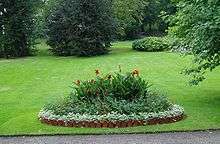Pleasure ground

The pleasure ground is an area of garden near to a building in landscape gardens of English style that, in contrast to the outlying park, stresses artistic elements over the more natural elements.
Concept
The German landscape gardener, Hermann, Prince of Pückler-Muskau, explained the meaning of this term in his 1834 publication Andeutungen über Landschaftsgärtnerei ("Ideas On Landscape Gardening") as follows:
- "The word pleasure ground is difficult enough to render in German and I have therefore felt it better to retain the English expression. This means a piece of land adjacent to a house, which is fenced in and ornamented, of much greater extent than gardens, and something of an intermediate thing, a connecting element between the park and the actual gardens."[1]
- And further: "[...] if the park is an idealised, condensed piece of the natural world, so the pleasure garden is an extended residence [...] in this way [...] the suite of rooms, is continued on a larger scale in the open air, [...][2]
Pückler-Muskau's description refers to one of the three elements of the English landscape garden that are, from the outer perimeter of the estate to its main building, the park, the pleasure ground and the flower gardens. Usually there was also a flower-bedecked terrace on the house itself so that the transition from the open countryside to the house was in several stages.
History
The type of garden known as the pleasure ground in the shape of an ornamented area of lawn right next to the house was already known in England during the Renaissance, and from the second half of the 18th century it became very popular. Encouraged by the landscape architect, Humphry Repton, this division of the grounds of a country house spread to Germany around 1800 and was employed inter alia by Prince Pückler-Muskau and Peter Joseph Lenné, who made use of it in their designs at Muskau, Glienicke and Babelsberg. The first pleasure ground in Prussia is probably that laid out at Glienicke Palace by Lenné in 1816.
Sources
- Klaus-Henning von Krosigk, chapter about the pleasure ground in: Dieter Hennebo: Gartendenkmalpflege. Verlag Eugen Ulmer, Stuttgart 1985, p. 232–253.
- Klaus-Henning von Krosigk: Klein-Glienicke mit Pleasureground. In: Landesdenkmalamt Berlin (ed.): Gartenkunst Berlin. 20 Jahre Gartendenkmalpflege in der Metropole. Schlezky & Jeep, Berlin 1999
- Anne Schäfer: Der Pleasureground und die Sondergärten in Branitz. In: Kommunale Stiftung Fürst Pückler Museum – Park und Schloß Branitz (ed.): 150 Jahre Branitzer Park. Cottbus 1998, p. 90–99